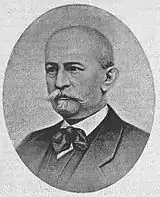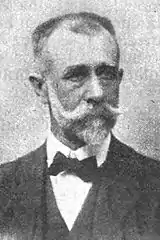Rafael Díez de la Cortina y Olaeta
Rafael Díez de la Cortina y Olaeta, 1st Count of Olaeta (1859–1939) was a Spanish-American linguist. Globally he is recognized as the first person to introduce sound recording into the teaching of foreign languages; he used it when operating his New-York-based company, Cortina Academy of Languages, launched in the 1890s. In Spain he is also known as a Carlist political activist and soldier; he volunteered to legitimist troops during the Third Carlist War and advanced the Carlist cause as the claimant's representative in America.
Rafael Díez de la Cortina y Olaeta | |
|---|---|
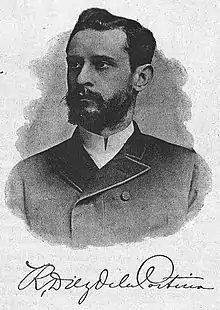 | |
| Born | Rafael Díez de la Cortina y Olaeta 1859 |
| Died | 1939 |
| Nationality | Spanish |
| Occupation | publisher, entrepreneur |
| Known for | linguist |
| Political party | Carlism |
Family and youth
The Díez de la Cortina[2] family originated from Cantabria and were related to Liébana; the first representative is noted in the 16th century.[3] As part of hidalguia, none of the family members grew into a public figure until in the mid-18th century one of its branches moved to the Andalusian Marchena;[4] they settled as arrendatarios in estates of Duque de Osuna. The great-grandfather of Rafael, José Antonio Díez de la Cortina Gutiérrez,[5] was born in the Cantabrian Potes[6] and upon his arrival in Marchena he built a house, which was later to become a family hub.[7] Rafael's grandfather, Juan Díez de la Cortina Layna Pernia (born 1782), as the oldest surviving son became the family heir; in the 1830s he was already one of the top local taxpayers.[8] In the 1840s he formed part of the emerging "agrarian bourgeosie",[9] a group of local hidalgo families which grew into major proprietors as duque de Osuna was selling out his estates.[10] Though not comparable to grand Andalusian landholders,[11] they soon assumed a leading role in the local agricultural regime.[12]
The oldest son of Juan and the father of Rafael, José Díez de la Cortina Cerrato (died 1874), owned some 400 ha and rented further 700 ha; he was the 6th largest arrendatario in Marchena.[13] At unspecified time he married Elena Olaeta Bouyon, a native of San Fernando;[14] none of the sources consulted provides detailed information on her parentage; she was descendant to two very distinguished Cádiz families of navy commanders and public servants; both the Olaetas[15] and the Bouyons[16] made their names in Spain and in the New World. José and Elena had three children, all of them sons, born between 1855 and 1859; Rafael was the youngest one.[17]
Nothing certain is known about Rafael's education.[18] When in the United States he married twice: in 1897 with a woman of Irish parentage, New York-born[19] Marguerete Canto Ingalis (1864–1933),[20] and in 1933 with Hartford, Connecticut-born[21] Marion L. M. Fletcher (b. 1872).[22] None of the sources consulted claims he had any children and there were none mentioned as involved in property-related issues.[23] He lived at various locations in New York, including at Riverside Drive 431 in Manhattan,[24] before moving to Middletown, New York.[25] Upon his sudden death in 1939,[26] he was buried at the Woodlawn Cemetery in Bronx.[27] The best known relative of Rafael is his older brother José, who in the early 20th century became a Carlist political leader in Andalusia and member of the national party executive. Rafael's distant relative was José Gómez Acebo y Cortina, a conservative politician who held various ministerial jobs during final years of the Restoration. The Carlist title of Conde de Olaeta, conferred upon Rafael in 1876, was claimed by Mariano Ternero Caro in 2002,[28] but has not been recognized by the Madrid court so far. Some other relatives gained limited local recognition.[29]
Volunteer in Third Carlist War
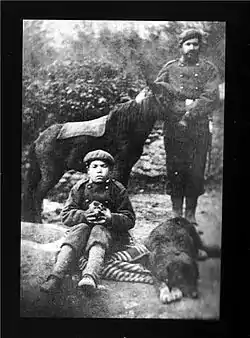
There is no information on political preferences of the Díez de la Cortina until the mid-19th century;[30] in the 1860s various members of the family, including José Díez de la Cortina Cerrato, his wife and sons, started to appear as signatories of various open letters printed in Neo-Catholic and Traditionalist papers; they pledged loyalty to the Catholic Church and lambasted "corrupción de las ideas y de costumbres", especially in education.[31] Later his son recollected that it was the 1868 revolution and its aftermath which triggered Díez de la Cortina Cerrato's access to Carlism;[32] in 1870 he already declared his "completa adhesión al señor Duque de Madrid".[33] When the Carlist insurgency rocked Vasco-Navarrese provinces in 1872 he pondered upon joining the rebels, the idea which soon became his obsession.[34] In June 1873 the 17-year-old Rafael's brother José was dispatched North to agree the logistics and learn the war craft.[35] Upon his return to Marchena in October 1873 Cortina Cerrato formed a family-based group, consisting of the father, Rafael and his two brothers, his cousin, few family associates including a chaplain and a lawyer, some servants and a handful of volunteers.[36] The 20-men unit, of which Rafael was the youngest member, headed North.[37] In two weeks they covered some 350 kilometers across the provinces of Córdoba, Jaén, Ciudad Real and Cáceres, finally joining the 300-men column[38] of general Vicente Sabariegos.[39]

Surrounded by family members, starting November Cortina commenced combat during failed skirmishes at Retamosa; upon death of Sabariegos, command was assumed by general Villar y Perez. During late 1873 and early 1874 the group fought guerilla war across New Castile, Extremadura and La Mancha, engaged at Villar del Pedroso, Navahermosa, Montiel, Santa Cruz de los Cañamos, Talavera la Vieja (November), Torre del Campo (December), Puertollano,[40] Los Yébenes, Talarrubias (January), Alcoba, Garbayela, Artiñano, Agudo, (February), Moral de Calatrava and Luciana (March).[41] The campaign ended in April 1874 at Piedrabuena,[42] when during close engagement his father and the oldest brother Juan were killed in action.[43] The two brothers who survived the carnage, José (who was wounded),[44] and Rafael (who had his horse shot)[45] made it to Portugal[46] and from Lisbon sailed to Bordeaux, in late spring of 1874 via Pau crossing to Carlist-controlled area in the North.[47] While his older brother joined the cavalry, Rafael was assigned to artillery; as teniente serving initially in central Navarre under command of coronel Prada,[48] later promoted to capitán he joined 2. Batería Montada of Atilano Fernández Negrete, forming part of the Vasco-Navarrese troops.[49] It is not clear whether he served in the same unit throughout 1875. In early 1876, during final months of the war, the claimant rewarded Rafael with condado de Olaeta.[50] At unspecified time he was promoted to comandante,[51] though some sources claim he ended the campaign as teniente coronel.[52] Reunited with his brother, they parted the claimant in Arneguy, the first French town on their way to exile.[53]
Carlist representative in America
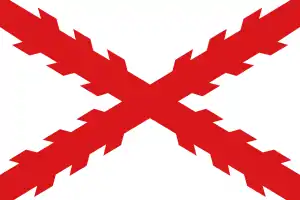
Cortina's early whereabouts on exile are obscure; 1878 latest he settled in Paris.[54] In 1879 he "was sent" by his king to Mexico; no details are known.[55] In 1881 he sailed from Mexico to New York[56] and commenced teaching Spanish. Starting the 1880s he acted as representative of Carlos VII in North America.[57] He remained on good terms with the claimant, who wrote a recommendation letter published in the 1889 Cortina's language textbook.[58] Naturalized in 1889,[59] he visited Spain every few years;[60] in 1895 Cortina extended his voyage to Venice,[61] where he meet his king personally.[62] Neither press of the era nor present-day historians explain exact nature of his activities prior to the late 1890s;[63] one author notes that no tangible results of his political mission in the US are known.[64]
Cortina was most active in 1896–1898, during the run-up to the Spanish–American War. Busy in the Hispanic New York community[65] and contributing to a daily Las Novedades,[66] he tried to confront the anti-Spanish frenzy of American press and complained about lack of assistance on part of Madrid, the charges which thanks to Vázquez de Mella reached the Cortes and the government in 1896.[67] Following a visit in Spain,[68] starting 1897 Cortina changed the tone of his press endeavors; he switched to advertising the claims of Carlos VII. Thanks to his efforts few US periodicals, including New York Herald, published pieces on Carlism.[69] Some quoted Cortina say that 100,000 volunteers waited for an order to rise and that by January 1, 1898, Don Carlos would assume the throne, though also that the claimant would do nothing which might impair international standing of his country.[70]

In May 1898, in the midst of virulent anti-Spanish press campaign, a number of papers quoted interviews with Cortina and discussed Carlist claims as proof that the Madrid government might fall any minute. Headlines[71] and narration[72] helped to mobilize the American public opinion, though this was not Cortina's intention.[73] In May 1898 he transferred the realization of his prediction to June 1, 1898,[74] called the Carlists of America to join the claimant and declared he would travel to Europe shortly.[75] It is not clear whether he did indeed; one source claims vaguely that he "took part in the 1898-1899 conspiracy."[76] He might have been involved in shipment of arms to Carlist conspirators, though nature of his engagement is highly unclear. In 1901 a Spanish military attaché in Washington reported to Madrid that Cortina helped him identify a cargo of 5,000 rifles, sent from New York to Lisbon and intended for a Carlist depot in Badajoz.[77] It is not clear whether Cortina changed sides or he worked for the Carlists and for the Madrid government at the same time. Though also in the 20th century Cortina frequently visited Spain,[78] he was hardly reported as engaged in Carlist activities,[79] focused on promotion of his linguistic business.[80] During resurgence of Carlism in the 1930s he was not mentioned in party propaganda.[81]
Linguist and businessman

In the early 1880s Cortina commenced teaching Spanish. His own marketing[82] and independent reviews alike[83] claimed that Cortina Institute of Languages was set up in 1882. Throughout the 1880s he was rather noted as giving lessons[84] offered by other institutions, e.g. in 1887 by Brooklyn Library[85] or in 1889 by Brooklyn YMCA.[86] The breakthrough work which helped him launch own business was the 1889 publication titled The Cortina Method to Learn Spanish in Twenty Lessons.[87] Instead of systematically mastering linguistic structures, deemed laborious and inefficient,[88] Cortina - claiming to be M.A. graduate of University of Madrid[89] - focused on practical skills. In 1891 he was already boasting a program based on "the Cortina method",[90] and in 1892 the Cortina School of Languages started to advertise.[91] At the time he was running an established business already. Set in two locations in Brooklyn and Manhattan, the school offered 9 languages,[92] taught in 20 lessons by native instructors.[93]
It is not clear whether from the onset "the Cortina method" entailed mechanically-aided learning. Some claim that already in the mid-1880s Cortina experimented with phonograph recordings, possibly in co-operation with Thomas Edison.[94] It was in 1893 that his method was reported in The Phonogram, an academic journal,[95] and he became the first person to use phonograph for foreign language instruction.[96] It soon became a second leg of his business, as on-site learning was paired with development of self-learning correspondence courses and production of related aid materials. They consisted of two types. One was own textbooks; they contained excerpts from literary works,[97] though also phrases tailored for daily usage.[98] Another one was recordings. Initially phonograph-intended cylinders were used;[99] first branded by Cortina, after 1896 they were made by Edison's National Phonographic Company.[100] In 1908 he registered the trademark of Cortinaphone, selling own brand of phonograph, and since 1913 his company started to issue flat round recordings.[101] The Cortina school kept using English for instruction until 1920, when they switched to target language only.[102] Around 1920 he was marketing "Cortina phonograph outfit", advertised as more efficient than teaching by instructors.[103]
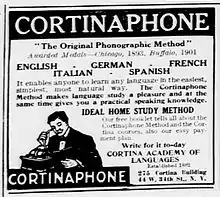
Cortina's language business gained acknowledgement.[104] His method of teaching was awarded corporate prizes;[105] the school – since 1899 named Cortina Academy of Languages[106] - made arrangements with prestigious New York colleges[107] and had to rent bigger and bigger premises at prestigious downtown locations;[108] other teaching institutions advertised themselves as adhering to his methodology;[109] the publishing house he set up kept re-printing textbooks and manuals in endless editions while audio materials were published jointly with Columbia Records.[110] Correspondence courses of English proved successful in South America and Mexico.[111] Cortina business developed also in Spain, as the owner was granted official governmental recommendation and remained on good terms with education officials.[112] His teaching method enjoyed largely positive reception among academics of that time;[113] also contemporary scholars note that it "marks a great advance in language teaching".[114] The language school he created was later renamed to Cortina Institute of Languages and is operational until today.[115]
See also
Footnotes
- according to some authors he was born in Marchena, see Susana Diez de la Cortina Montemayor, La influencia de Diez de la Cortina en la evolución de la enseñanza a distancia del español como lengua extranjera, [in:] La Voz de Marchena 27.10.15, available here. According to his own statements made before US authorities, e.g. when applying for a passport, he was born in Seville.
- the name appeared in contemporary press in a variety of spelling versions: "Díez de la Cortina", "Díez de la Cortina", "Díez de Cortina", "Díez de Cortina", "Diaz de la Cortina", "Díaz de la Cortina", "Diaz de Cortina", "Díaz de Cortina" or "D. de la Cortina"
- Ramón Luis Retamero Díez de la Cortina, Raíz de los Díez de la Cortina procedentes de Marchena, s.l. 2013, p. 5
- Retamero 2013, p. 5
- full name José Antonio Díez de la Cortina Gutiérrez de Caviedes
- Retamero 2013, p. 26
- in the 1990s the building was declared part of local historical patrimony and covered with appropriate regional protection scheme, see Marchena. Plan espacial de protección del conjunto histórico, Ficha No. 16: Casa palacio de José Díez de la Cortina, available here. However, the building kept dilapidating; currently there are only few walls standing, compare google.maps service, available here
- José Fernando Alcaide Aguilar, Marchena durante la regencia de María Cristina. Aspectos políticos, sociales y económicos, [in:] Actas de las IV Jornadas sobre Historia de Marchena, Marchena 1999, pp. 31, 38
- Alcaíde 1999, p. 54
- Adrian Shubert, José Luis Gil Aristu, Historia social de España (1800-1990), Madrid 1991, ISBN 9788486763473, p. 110, Rafael Mata Olmo, Pequeña y gran propiedad en la depresión del Guadalquivir, Madrid 1987, ISBN 9788474795240, pp. 110-112
- few of them owned an estate larger than 1,000 ha while Duque de Osuna, a typical case of grand Andalusian landowner, possessed some 8,000 ha, Mata 1987, p. 108
- Marchena was a rather exceptional county; in most of Andalusian counties it was the grand properties which prevailed: "la gran propiedad de Marchena en 1860 constituye, frente al caso cordobés analizado, un buen exponente de latifundio más evolucionado y próximo al capitalismo agrario pleno", Mata 1987, p. 105, general discussion pp. 105–125
- Mata 1987, p. 117
- Libros del registro civil de Sevilla (/1836/1841-1882). Libros de partes parroquiales (1842-1880), [in:] Archivo Municipal de Sevilla
- compare e.g. El Comercio 11.03.50, available here
- Guillermo C. R. G. Perez, Honorato Bouyon Serze, [in:] Contando Historias Antiguas blog, 23.12.14, available here
- [Ramón Luis Retamero Díez de la Cortina?], Informe Genéalogico Completo de Juan Díez de la Cortina, s.l. 2013, p. 15
- in 1890 in the United States he claimed to have been the M.A. graduate of University of Madrid, see The Evening Post 18.10.1890, available here
- National Archives and Records Administration [furtherly referred as NARA] 2002, roll T626, available online here
- NARA rolls M1490 and M1372, available online here, NARA roll T715, available online here. His wife's father was Timothy Canto; her mother is once identified as Margaret Carr, New York Municipal Archives, FHL microfilm 2,070,584, available online here, and once as Margt T. Flynn, New York City Municipal Archives, FHL microfilm 1,487,674, available online here. She is also referred to also as Marguerite, see David Saunders, George Delacourte Jr., [in:] Pulp Artists service 2004, available here. By the end of her life she was engaged in local charity initiatives and set up Thimble Charity in Middletown, New York, see Middletown Times Herald; 27.07.33, available here
- NARA T715 roll, available online here
- either a widow or a divorcee, daughter of Fred P. Mahl and Marion Hamilton, New York City Municipal Archives, FHL microfilm 1,684,806, available online here, see also NARA T715 roll, available online at here
- see e.g. discussion on mortgage obligations resulting from death of his first wife, Middletown Times Herald 27.07.33
- Saunders 2004
- the date is not clear. In the early 1910s his wife was reported in local charity initiatives, Annual Report to the State Board of Charities and Nineteenth Annual Report to the State Commission in Lunacy, New York 1911, p. 27; in the mid-1930s he was explicitly reported as living in Middletown, New York, and shortly before death he moved to Beattie Avenue 23, one more location there, Middletown Times Herald 24.07.39, available here
- as a result of accident he suffered, with ribs and shoulders fractured he passed away in the Horton Hospital, Middletown, New York, on July 24, 1939, Middletown Times Herald 24.07.39
- in 2017 the cemetery website featured him as a personality facilitating New Year resolutions, see here, see also the same site recommending him as self-improvement pioneer here
- Revista Hidalguía 296 (2003), p. 7
- the Torres Díez de la Cortina relatives gained some acknowledgement in the late 19th century as local bull-breaders in Western Andalusia. Their ganaderia was sold in the late 19th century, see García Jiménez, Hermanos entry, [in:] ganaderias.toroslidia service, available here
- during the First Carlist War Marchena was briefly taken by the Carlists but there is no note of any Díez de la Cortina involved; later on the alcalde claimed in report to higher authorities that there were no Carlist supporters in the area, Alcaide 1999, pp. 46-47
- El Pensamiento Español 13.07.64, available here
- José Díez de la Cortina, El fracaso de un plan, [in:] Tradición 16 (1933), p. 387
- La Regeneración 25.05.70, available here
- Díez de la Cortina 1933, p. 387
- Díez de la Cortina 1933, pp. 387-388
- B. de Artagan [Reinaldo Brea], Principe heroíco y su soldados leales, Barcelona 1912, p. 118
- Díez de la Cortina 1933, p. 388, Ferrer 1955, p. 175
- almost all of them cavalry, Ferrer 1955, p. 168
- Díez de la Cortina 1933, p. 389
- where they broke up a local prison and set the prisoners free, Melchor Ferrer, Historia del tradicionalismo español, vol. 26, Sevilla 1955, p. 234
- Díez de la Cortina 1933, pp. 389-390; slightly different sequence in Ferrer 1955 (26), pp. 234-242, 273
- detailed account in Ferrer 1955 (26), pp. 241-245. A very picturesque and dramatic account of Piedrabuena episode in Diario de Valencia 05.05.12, available here
- Díez de la Cortina 1933, pp. 390-391
- Ferrer 1955 (25), p. 175
- El Estandarte Real July 1889, available here
- he joined troops of Coronel Villar. Then in Ciudad Real he joined another Carlist unit, within its ranks withdrawing to Portugal, Brea 1912, pp. 122, 125
- El Estandarte Real July 1889
- El Estandarte Real November 1889, available here
- Brea 1912, p. 125
- Ferrer 1955 (26), p. 325
- Francisco de Paula Oller, Don Rafael Díez de la Cortina, [in:] El Estandarte Real II/20 (1890), available here
- Ferrer 1955 (25), p. 175
- El Estandarte Real July 1889
- Brea 1912, p. 125
- "el año de 1879 fué enviado por Don Carlos de Borbón y de Austria-Este á Méjico", Brea 1912, p. 125
- NARA M237 roll, available online here; in his later passport applications he made conflicting claims that he arrived in the US in 1882 either from Le Havre – NARA rolls M1490 and M1372, available online here - or from La Habana, NARA 1490 and M1372 rolls available online here or from Vera Cruz, NARA 1490 and M1372 rolls available online at here
- Ferrer 1955 (25), p. 175, Jordi Canal, El carlismo, Madrid 2000, ISBN 8420639478, p. 237, Agustín Fernández Escudero, El marqués de Cerralbo (1845-1922): biografía politica [PhD thesis], Madrid 2012, p. 182. According to some he was the Carlist representative in the US only, Brea 1912, p. 125
- for original handwritten note see reproduction at Archive.org service, available online here
- NARA 1490 and M1372 rolls available online here
- first identified trip took place in 1889, NARA 1490 and M1372 rolls available online at here; he also travelled to Spain in 1891, El Heraldo de Madrid 05.09.1891, available here
- El Baluarte 19.05.1895, available here
- El Baluarte 02.06.1895, available here
- it is known that he served as first point of contact for Carlist-recommenced guests in New York, Francisco Melgar, Veinte años con Don Carlos. Memorias de su secretario, Madrid 1940, pp. 62–63
- "no conocemos resultados tangibles de su actividad", Melchor Ferrer, Historia del tradicionalismo español, vol. 28/1, Sevilla 1959, p. 231
- some authors claim he contributed to development of Hispanic theatre in the United States; two plays issued by his publishing house as auxiliary materials to learn Spanish, Después la lluvia el sol (1879) and El indiano (1893) are attributed to him with a reservation that there is no indication any of them has ever been staged, Nicolás Kanellos, A History of Hispanic Theatre in the United States: Origins to 1940, Austin 1990, ISBN 9780292730502, pp. 104-105, 215
- full title Las Novedades. España y los Pueblos Hispano-Americanos, a review issued between 1877 and 1905. For detailed discussion of this and other Hispanic papers in New York see Vernon A. Chamberlin, Ivan A. Schulman, La Revista Ilustrada de Nueva York, New York 1976
- El Correo Español 18.08.1896, available here
- he returned to New York in September 1896, NARA rolls T715 and M237, available online here
- see To crown Carlos, [in:] New York Herald 19.09.1897, referred after El Regional 15.10.1897, available here
- see e.g. Kansas City Journal 03.10.1897, available here
- like "For Thirty Years He and His Followers Have Been Striving to Take Advantage of Just Such a Crisis in Spanish Affairs", The San Francisco Call 08.05.1898, available hhere
- like "it is believed there is a plot to overthrow the Spanish dynasty at once", The Brownsville Daily Harald 07.05.1898, available here
- in 1889, upon his first passport application, he signed a standard declaration that "I will support, protect and defend the Constitution and Government of the United States against all enemies, whether domestic or foreign; and that I will bear true faith, allegiance and loyalty to the same, any ordinance, resolution or law of any State, Convention or Legislature to the contrary notwithstanding", NARA rolls M1490 and M1372, available online here
- The San Francisco Call 08.05.1898
- Don Carlos Manifesto, [in:] Albuquerque Daily Citizen 07.05.1898
- and was even promoted to "coronel en la conspiración de 1898-1899", Ferrer 1955 (25), p. 175
- "En III/IV-1901, el agregado militar de la embajada española en Washington, Federico de Monteverde, localizó a través del confidente Rafael Díaz [note different spelling, which is probably irrelevant anyway] de la Cortina un presunto alijo de 5.000 fusiles Remington que eran enviados desde enero con destino a Lisboa y Badajoz (cartas de Monteverde al Ministerio de Guerra, 30-III y 9, 12 y 19-IV-1901, en SHM, Archivo General Militar, 2a Sección, 4a División, leg. 125: Orden público: Movimiento carlista, 1837-1906 y carta del embajador en Washington, 20-IV-1901, en AMAE, Política Interior, leg. H 2846: Carlistas, 1900", Eduardo González Calleja, La razón de la fuerza: orden público, subversión y violencia política en la España de la Restauración (1875-1917), Madrid 1998, ISBN 9788400077785, p. 337
- at least in 1905, 1908, 1910, 1913, 1929, 1930, 1934, 1935. When in Spain he used to give lectures on languages, compare Nuevo Diario de Badajoz 25.01.05, available here
- the thread identified was his engagement in building a monument to Juan Vazqyez de Mella. In 1930 he donated money, see La Epoca 01.01.30, available here, and in 1934 he was present in Cangas de Oniz attending a feast related to unveiling of the bust, El Siglo Futuro 24.08.34, available here
- though until death he publicly used the "Count of Olaeta" title, at least in the United States, and this is how he was also referred to in the press, see e.g. Middletown Times Herald 24.06.39, available here
- e.g. a luxury 1933 publication celebrating a centenary of Carlism published a brief note on his father, his brother and his cousin, but contained no mention of Rafael, see [Juan María Roma], Album historico del Carlismo, Barcelona 1933
- The Evening Post 30.09.1893, available here
- Cortina Looks Towards Racks, [in:] Billboard 25.04.64, p. 6, available here
- though apparently he already made his name as a teacher; 1886 he had his apartment at 131 West Street 31 robbed, including money and business cards; the burglar later pretended to be him before apprehended, The Sun 15.10.1886, available here
- The Brooklyn Daily Eagle 30.10.1887, available here
- The Brooklyn Daily Eagle 14.10.1889, available here
- Carl G. Franzén, Foreign Language in the Curriculum, [in:] Bulletin of the School of Education Indiana University 34 (1958), p. 17, referred after Patricia Sue Bryant, A Study of the Development of Secondary School Modern Language Programs in the United States [MA thesis Kansas State University], Manhattan 1965, p. 23
- he wrote: "It is a well-known fact that, by the old methods of study, only a few students obtain any degree of fluency in speaking a language that is foreign to them. It is true th t many of them can, after a number of years spent in study, conjugate, decline, analyze, and translate a sentence into English, but they are seldom able to put an English sentence into an idiomatic foreign one. Such learning, although laboriously acquired, is of little practical value, end the tourist or commercial traveller finds himself in an awkward dilemma when forced to ask for even the everyday necessaries of life in a foreign tongue", quoted after Bryant 1965, p. 24
- The Evening Post 18.10.1890, available here
- The Evening Post 10.10.1891, available here
- The Brooklyn Daily Eagle 09.10.1892, available here
- not only Spanish but also English, French, German, Italian, Portuguese, Russian, Latin and Greek
- The Brooklyn Daily Eagle 09.10.1892, available here
- Kenji Kitao, The History of Language Laboratories. Origin and Establishment [working paper of Doshisha University], Kyoto 1995, p. 5
- Kitao 1995, p. 6
- Kitao 1995, pp. 6-7
- the first named are two plays he fathered himself: Despues de la lluvia el sol (comedy in 1 act) and El Indiano (comedy in 3 acts inspired by Ricardo García de la Vega). The remaining ones are novels (Amparo by Enrique Pérez Escrich), collections of stories (El Final de Norma by Alarcón, Temprano y con sol, forwarded by Emilia Pardo Bazán, El Molinerillo) or brief accounts of historical events from Spanish history (Episodios en español y anotados en inglés). They were edited in Spanish and English on opposing pages, most of them published by his own publishing house, R. D. Cortina Company
- most are styled after his first highly successful Spanish in Twenty Lessons: Inglés en Veinte Lecciones, French in Twenty Lessons, Francés en Veinte Lecciones, Español en Español, English in English, Francais en Francais, Deutsch auf Deutsch, Italiano in Italiano, English in English with Key in Portuguese. Another category were dictionaries, like Verbos españoles: diccionario de la conjugación castellana, Cortina’s Spanish-English and English-Spanish Vest Pocket Dictionary and Instructor. Finally, he published letter-writing guides, best known Modelo para cartas en español (with prologue by Vázquez de Mella). He reacted to ongoing events quickly and demonstrated lots of flexibility. When the American troops landed on European shores in 1917, he had already published Cortina French-English Military Manual, Cortina French-English Military Dictionary, Cortina French-English Red Cross Instructor and Cortina Soldier’s Map of the French Front and Handy War Guide for My Company, compare Jean A. Picard, Cortina French-English Military Manual, New York 1917, p. 278
- Kitao 1995, p. 6
- Kitao 1995, pp. 6-7
- Kitao 1995, p. 6
- Kitao 1995, pp. 6-7
- Picard 1917, p. 276
- though already in the late 1890s Cortina was by no means the single company offering recording-aided correspondence courses on the US market. Similar business was developed by Richard S. Rosenthal as The Meisterschaft System (later dubbed also Rosenthal Method and Language Phone Method) and by Thomas J. Forster, known as International Correspondence School of Scranton, Kitao 1995, p. 9
- 1893 he was awarded prize by Dept of Liberal Arts at Columbian Exposition in Chicago, 1901 at Pan-American Exposition in Buffalo, Picard 1917, p. 277
- The Brooklyn Daily Eagle 06.10.1899, available here
- e.g. the Long Island Business College, The Brooklyn Daily Eagle 09.09.00, available here
- in 1912 he claimed that due to "tremendous success" Cortine offices were moved to a new, more spacious and more prestigious location in central Manhattan, The Sun 10.03.12, available here
- The Sun 13.01.18, available here
- The Evening World 23.08.18, available here
- Kitao 1995, p. 6. The students were also in position to record their spoken language and send cylinders to New York Cortina's office for evaluation of their progress
- in 1899 Cortina’s textbooks obtained official recommendation of Ministerio de Ultramar. An anonymous author appearing as "El buscador de historias" claims also he obtained official recommendation of "el rey", a reference which against general backgroung of the article seems to point to Alfonso XIII (and not Carlos VII, who indeed provided such a recommendation), see La academia de idiomas „Made in Spain” que se anticipó 100 años a los métodos a distancia, [in:] Memoria de Marchena service, available here
- see letters published in Picard 1917, pp. 277-279
- Frenzen 1958, pp. 17-18, Bryant 1965, p. 24
- see the official website of Cortina Institute of Languages, available here
Further reading
- B. de Artagan [Reinaldo Brea], D. José Díez de la Cortina Cerrato, sus hijos D. Juan, D. José y D. Rafael Díez de la Cortina y de Olaeta, y su sobrino D. Alejandro Díez de la Cortina, [in:] B. de Artagan, Príncipe heróico y soldados leales, Barcelona 1912, pp. 118–126
- Patricia Sue Bryant, A Study of the Development of Secondary School Modern Language Programs in the United States [MA thesis Kansas State University], Manhattan 1965
- José Díez de la Cortina, El fracaso de un plan, [in:] Tradición 16 (1933), pp. 387–391
- Carl G. Franzén, Foreign Language in the Curriculum, [in:] Bulletin of the School of Education Indiana University 34 (1958), pp. 1–28
- Kenji Kitao, The History of Language Laboratories. Origin and Establishment [working paper of Doshisha University], Kyoto 1995
- Theodore Huebner, Fifty Years of Foreign Languages in New York City, [in:] Hispania 47 (1964), pp. 781–785
